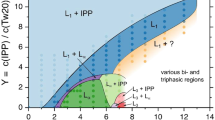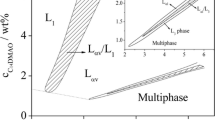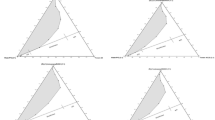Abstract
In binary Macrogolstearate 400 (MS 400)/water systems, lamellar surfactant arrangements can be detected by polarized light and transmission electron microscopy. As demonstrated by X-ray diffraction and differential scanning calorimetry, the alkyl chains of the emulsifier are in the crystalline state. Ternary systems with liquid paraffin represent optically isotropic, homogeneous o/w creams for a wide composition range. Incorporation of up to 50 mol% cholesterol into the MS 400 lamellar structures leads to a gel-liquid crystalline phase separation within the bilayer, thus enabling the formation of spherical nonionic vesicles. The transition enthalpy of the samples decreases linearly with increasing cholesterol concentrations. The Macrogolstearate 400/cholesterol vesicles proved to be stable in hydrophilic cream systems. Cationic vesicles can be prepared using cetyltrimethylammonium bromide (CTAB) as a charge inducer. Low-CTAB portions are inhomogeneously distributed within the bilayer, as detected by DSC. The results also indicate a perturbation of the alkyl chains packing for the positively charged vesicles.
Similar content being viewed by others
REFERENCES
C. Müller-Goymann. Halbfeste emulsionsähnliche Zustände. SÖFW 110:395 (1984).
C. Müuller-Goymann. The influence of the microstructure on consistency and physical stability of an O/W cream. Acta Pharm. Technol. 33:60 (1987).
H. E. Junginger. Kristalline Gelstrukturen in Cremes. Deutsche Apothekerz. 131:1933 (1991).
B. W. Barry. The control of oil-in-water emulsion consistency using mixed emulsifiers. J. Pharm. Pharmacol. 21:533 (1969).
B. E. Barry. Structure and rheology of emulsions stabilized by mixed emulsifiers. Rheol. Acta 10:96 (1971).
N. Krog and J. B. Lauridsen. Food emulsifiers and their associations with water. In S. Friberg (ed.), Food Emulsions, Marcel Dekker, New York, 1976.
C. Tanford. The Hydrophobic Effect: Formation of Micelles and Biological Membranes, John Wiley, New York, 1980, p. 132.
C. Müller-Goymann and C. Führer. Participation of liquid crystals in emulsions, creams and gels. 3rd Int. Conf. Pharm. Technol., Paris, 1983.
H. Lautenschläger and J. Rding. Kosmetische Formulierungen mit Phospholipiden und Liposomen—Umfeld und Zusammenhänge, Vortrag anläßlich der SEPAWA-Jahrestagung 1989, Bad Dürkheim, 5.10.1989.
A. Helenius and K. Simons. Solubilization of membranes by detergents. Biochim. Biophys. Acta 415:29 (1975).
A. T. Florence and A. J. Baillie. Non-ionic surfactant vesiles—alternatives to liposomes in drug delivery? In L. F. Prescott and W. S. Nimmo (eds.), Novel Drug Delivery and Its Therapeutic Application, John Wiley, New York, 1989.
A. D. Bangham, M. M. Standish, and J. C. Watkins. Diffusion of univalent ions across the lamellae of swollen phospholipids. J. Mol. Biol. 13:238 (1965).
H. Junginger, W. Heering, C. Führer, and I. Geffers. Transmissionsmikroskopische Untersuchungen kolloider Salben-und Cremestrukturen. Beitr. elektronenmikroskop. Direktabb.Oberfl. 14:465 (1981).
C. Müller-Goymann and C. Führer. Flüssigkristalline Mesophasen in cholesterolhaltigen Cremes und ihr elektronenmikroskopisches Erscheinungsbild. Acta Pharm. Technol. 28:243 (1982).
A. Tardieu and V. Luzzati. Structure and polymorphism of the hydrocarbon chains of lipids: A study of lecithin-water phases. J. Mol. Biol. 75:711 (1973).
S. M. Small. Observations on lecithin. Phase equilibria and structure of dry and hydrated egg lecithin. J. Lipid Res. 8:551 (1967).
E. Sackmann. Physikalische und chemische Charakterisierung von Liposomen, Vortrag im Rahmen des APV Seminars Liposomen und Niosomen in Pharmazie und Kosmetik, Nürnberg 14–16 May 1990.
J. L. Ranck, L. Mateu, D. M. Sadler, A. Tardieu, T. Gulik-Krzywicki, and V. Luzzati. Order-disorder conformational transitions of the hydrocarbon chains of lipids. J. Mol. Biol. 85:249 (1974).
V. Paspaleeva-Küuhn. Assoziationsverhalten von Macrogolstearat 400 in wäßrigen Systemen—zur Kenntnis von Tensidgelen, hydrophilen Cremes und Vesikeln, Thesis, Universität Erlangen-Nürnberg, Germany, 1991.
Deutscher Arzneimittel Codex (1989).
D. Papahadjopoulos and H. K. Kemoelberg. Phospholipid vesicles (liposomes) as models for biological membranes: Their properties and interactions with cholesterol and proteins. Progr. Surg. Sci. 4:141 (1973).
E. Sackmann. Physical basis of trigger processes and membrane structures. In D. Chapmann (ed.), Biological Membranes, Vol. 5, Academic Press, London, 1984.
H. Eibl and A. Blume. The influence of charge on phosphatidic acid bilayer membranes. Biochim. Biophys. Acta 553:476(1979).
C. Tanford. The Hydrophobic Effect: Formation of Micelles and Biological Membranes, John Wiley, New York, 1980, p. 121.
W. M. Bertling, M. Gareis, V. Paspaleeva, A. Zimmer, H. Kreuter, E. Nürnberg, and P. Harrer. Use of liposomes, viral capsids and nanoparticles as DNA carriers. Biotechnol. Appl. Biochem. 13:390 (1991).
J. Funk, F. Wunderlich, and W. Kreutz. Thermotropic “two-stage” liquid crystalline-crystalline lipid phase separation in microsomal membranes. Biochim. Biophys. Acta 690:306 (1982).
Author information
Authors and Affiliations
Rights and permissions
About this article
Cite this article
Paspaleeva-Kühn, V., Nürnberg, E. Participation of Macrogolstearate 400 Lamellar Phases in Hydrophilic Creams and Vesicles. Pharm Res 9, 1336–1340 (1992). https://doi.org/10.1023/A:1015821821009
Issue Date:
DOI: https://doi.org/10.1023/A:1015821821009




